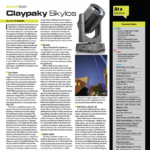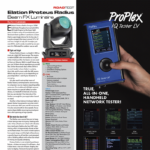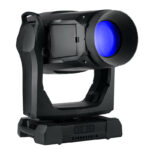LED ellipsoidal fixtures are the hottest and most debated product type on the market right now. But can you really call them ellipsoidal? Since LED profile fixtures don’t have an ellipsoidal reflector, the name doesn’t seem a perfect fit. They do have the same characteristics that we know and love from our old reliable tungsten-based fixtures, however. Maybe they should be called Lekos? That is just another angle of the debate going forward with these types of fixtures.
Just over a year ago, one of the biggest and oldest names in our industry, Altman Lighting, released their version of the LED profile fixture, the Phoenix LED Profile Spot. For years, Altman has been known for their innovative fixture design and built-in-the-USA product lines for our industry. If you had a unique application that required a specially-built fixture, their name was at the top of the list to call. The company, family-run since it was established in 1953, also have a long history and working with designers and technicians in the field to create lighting fixtures, grip equipment and custom products that have become commonplace in the market.
In recent years, Altman continued that tradition of designing and building products that rethink how fixtures work. In this case, it was their incorporation of a new class of light source —LEDs — without abandoning the way that traditional fixtures operate and perform.
I recently had a chance to give two of Altman’s Phoenix LED Profile Spot fixtures a try. This had to be one of the simplest road tests that I have ever had to do! The reason being, if you have ever worked with one of Altman’s tungsten-based ellipsoidals, or any other manufacturer’s ellipsoidal fixture, for that matter, the Phoenix will be easy to understand and operate.
The entire fixture range in the Phoenix LED series is straightforward and operates just like any other ellipsoidal on the market. There are some differences, however, with beam controls and, of course, controlling the light source, since we are dealing with LEDs instead of traditional bulbs.
Similar, but Different
The new Phoenix LED series is based exactly on the same body and features found on their Phoenix tungsten series — including the rigid flat steel dual-locking yoke handles, die-cast aluminum construction, locking shutter blades and 260° rotating barrel.
One key difference, however, is that LED engine’s associated heat sink and the fans required to cool and power the LED source are a bit heavier and bulkier than the tungsten series. As a result, the Phoenix LED series fixtures weigh in at 26 pounds compared to 16 pounds for the tungsten series.
Understanding the Series
Before I dive into the other features that are found across the series, I should note that there are various options when choosing a Phoenix. For starters, Altman offers a 150 watt and 250 watt version. Of course, the 250 watt version is brighter than the 150 watt version, by about 20 percent. Since the 250 watt version requires more power and produces more heat, Altman included a fan to cool the unit. Don’t fear, the fan is super quiet, so it should not be ruled out for use in theatrical and TV studio applications where fan noise might be an issue.
Pick Your Engine
After you choose which watt version you want, you have another important choice to make. Do you want to color mix, or just a plain white fixture? And if white, do you want daylight or a tungsten light source? The Phoenix offers light source options that RGBA, RGBW, 3000K and 5600K LEDs. All promise 50,000 hours of use.
Additional Options
So you’ve chosen your wattage and LED light source. Hold on, you still have more options to choose from when picking out your Phoenix! The fixtures come standard with either a 19°, 26°, 36° or 50° option, and cost a bit more if you want either a 5° or 10° fixture.
Those with an RGBA LED light source are available at the base price that’s the same for both the 150 and 250 watt versions ($1,950); then the price bumps up a bit for RGBW, 3000K and 5600K light source options, and, as noted, the 5° or 10° option. The MSRP pricing tops out for both the 150 and 250 watt versions at $2,450, although you can of course spend more by choosing from a wide array of accessories and spare parts.
All Altman’s fixtures, whether profiles, tungsten or LED, can also accept lens tube barrels made from other popular ellipsoidal manufacturers. After you’ve made all the other decisions on the perfect fixture to meet your needs, you have one last decision to make. Do you want your new Phoenix LED to come in black, white, silver or a custom color?
Choosing from among all these options may be the hardest part about adding Altman’s Phoenix LED to your lighting rig. If it seems like too much, of course, the people at Altman are happy to work with you and walk you though the options to find the best version of fixture to fit your needs.
Working with the Phoenix LED
I mentioned earlier that the Phoenix is easy to operate. It is! If you have ever worked with an ellipsoidal, getting your hands on the Phoenix will seem like nothing has changed. The difference, of course, comes when turning on the light source. Because it’s an LED fixture, there is no need for a dimmer to control the light level. That’s done through the 5-pin DMX via a controller. Local control is an option when a controller has not been setup yet, so it makes focusing quick. And the menu system built into the back of the Phoenix LED is easy to read and navigate. Again, Altman has made it simple with a few options and functions available at the rear of the fixture.
One of the big advantages of the Phoenix range’s LED light source, of course, is a serious reduction in the power usage when compared with a traditional tungsten-based fixture. With the Neutrik powerCON in and powerCON Pass though, you can power a number of the fixtures together off a single 20-amp non-dim circuit.
At a Glance:
A New Tradition Begins
Altman’s new Phoenix LED series is based on the same body and features found on their traditional Phoenix tungsten series. The difference, of course, is the LED light source, which promises advantages ranging from lower power draw and operating temperatures to 50,000 hours of use before the “bulb” needs to be changed. Fixture options include 150W and 250W with RGBA, RGBW, 3000K and 5600K LED Profile light source options.
Features:
- 360 degree rotating barrel
- Locking shutter
- Enclosed accessory holder
- Heat resistant Plano-Convex Lensing
- Die cast aluminum and sheet metal fabrication
- Color frame and spring clip safety cable included
- Tool free interchangeable barrels
- 3 foot powerCON power cable included
- C-Clamp included
- 26.45 lbs. (11.99 kg)
- ETL, cETL & CE listed.
- Lens tube included (except 5°& 10° lens)
Phoenix LED Profile Spot
Pros:
Operates and performs with traditional ellipsoidal simplicity; LED light source is more efficient and lasts longer than traditional bulbs.
Cons:
Upfront cost and weight are a bit heftier than traditional tungsten fixtures.
Price Range:
150W & 250W versions: $1,950-$2,450



